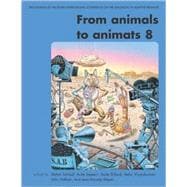
Note: Supplemental materials are not guaranteed with Rental or Used book purchases.
Purchase Benefits
Looking to rent a book? Rent From Animals To Animats 8 [ISBN: 9780262693417] for the semester, quarter, and short term or search our site for other textbooks by Schaal, Stefan; Ijspeert, Auke; Billard, Aude; Vijayakumar, Sethu; Hallam, John. Renting a textbook can save you up to 90% from the cost of buying.
| Preface | |
| The Animat Approach to Adaptive Behavior | |
| State of the Artificial Rat Psikharpax | p. 3 |
| Interactions of Environment, Behavior, and Synaptic Patterns in a Neuro-Robotic Model | p. 13 |
| Comparative Cognitive Robotics: Using Autonomous Agents as Empirical Models of Animal Learning | p. 23 |
| Morphology and Computation | p. 33 |
| Constructing an Animat Using 505 Sub-minds from 234 Different Authors | p. 39 |
| May We Have Your Attention: Analysis of a Selective Attention Task | p. 49 |
| Formalization of Recognition, Affordances and Learning in Isolated or Interacting Animats | p. 57 |
| Gallery Structure Formation in Conelyborus scarabaeoides | p. 67 |
| Perception | |
| Towards a Theory of How Bats Navigate through Foliage | p. 77 |
| From Bat Pinnae to Sonar Antennae: Augmented Obliquely Truncated Horns as a Novel Parametric Shape Model | p. 87 |
| Evolving Adaptive, High-Dimensional, Camera-Based Speed Sensors | p. 96 |
| Adaptive Object Tracking with an Anthropomorphic Robot Head | p. 104 |
| Morphology and Learning--A Case Study on Whiskers | p. 114 |
| Simulating Whisker Sensors--On the Role of Material Properties for Morphology, Behavior, and Evolution | p. 122 |
| Spatiotemporal Processing of Whisker Input Supports Texture Discrimination in a Brain-based Device | p. 130 |
| A Biomimetic Whisker for Texture Discrimination and Distance Estimation | p. 140 |
| Motor Control | |
| A Simple, Adaptive Locomotion Toy-System | p. 153 |
| GasNets and Other Evolvable Neural Networks Applied to Bipedal Locomotion | p. 163 |
| Adaptive Locomotion in a Complex Environment: Simulation of Stick Insect Gap Crossing Behavior | p. 173 |
| A Simulation Model of the Locomotion Controllers for the Nematode Caenorhabditis elegans | p. 183 |
| Planning the Sequencing of Movement Primitives | p. 193 |
| Biologically Inspired Adaptive Dynamic Walking of a Quadruped Robot | p. 201 |
| Action Selection and Behavioral Sequences | |
| Action Selection and Mental Transformation Based on a Chain of Forward Models | p. 213 |
| Self-Growth of Basic Behaviors in an Action Selection Based Agent | p. 223 |
| Optimal and Non-Optimal Compromise Strategies in Action Selection | p. 233 |
| Using Hormonal Feedback to Modulate Action Selection in a Competitive Scenario | p. 243 |
| Navigation | |
| A Spiking Neuron Model of Head-Direction Cells for Robot Orientation | p. 255 |
| Navigation and Cognitive Map Formation Using Aperiodic Neurodynamics | p. 264 |
| Adaptive Motor Primitive and Sequence Formation in a Hierarchical Recurrent Neural Network | p. 274 |
| Learning and Adaptation | |
| Competitive-Cooperative-Concurrent Reinforcement Learning with Importance Sampling | p. 287 |
| Estimating Future Reward in Reinforcement Learning Animats using Associative Learning | p. 297 |
| Hebbian Reinforcement Learning in a Modular Dynamic Network | p. 305 |
| Learning Human-like Movement Behavior for Computer Games | p. 315 |
| On Ashby's Homeostat: A Formal Model of Adaptive Regulation | p. 324 |
| Toward a Dynamical Systems Analysis of Neuromodulation | p. 334 |
| Homeostatic Plasticity in Recurrent Neural Networks | p. 344 |
| Evolution | |
| Evolving Walking: The Anatomy of an Evolutionary Search | p. 357 |
| The Force Model: Concept, Behavior, Interpretation | p. 364 |
| Evolving a Neurocontroller through a Process of Embryogeny | p. 373 |
| Collective and Social Behaviors | |
| Coordination and Behaviour Integration in Cooperating Simulated Robots | p. 385 |
| Effects of the Topology of Social Networks on Information Transmission | p. 395 |
| Evolving Functional Self-Assembling in a Swarm of Autonomous Robots | p. 405 |
| How Can a Life-like Agent Evoke Its Emotions For Users?--A Method for Inducing Users' Natural Behaviors to Establish "Mutual Adaptation" | p. 415 |
| Hamelin: A Model for Collective Adaptation Based on Internal Stimuli | p. 425 |
| BASC, a Bottom-up Approach to Automated Design of Spatial Coordination | p. 435 |
| The More Radical, the Better: Investigating the Utility of Aggression in the Competition among Different Agent Kinds | p. 445 |
| Imitation in Embodied Agents Results in Self-organization of Behavior | p. 455 |
| Adaptive Behavior in Language and Communication | |
| A Connectionist Approach to Learn Association between Sentences and Behavioral Patterns of a Robot | p. 467 |
| Imitation is not Enough for Lexicon Learning | p. 477 |
| The Sensorimotor Bases of Linguistic Structure: Experiments with Grounded Adaptive Agents | p. 487 |
| Applied Adaptive Behavior | |
| Evolving Opponents for Interesting Interactive Computer Games | p. 499 |
| Evolvable Recovery Membranes in Self-monitoring Aerospace Vehicles | p. 509 |
| Learning to Behave: Adaptive Behavior for Planetary Surface Rovers | p. 519 |
| Author Index | p. 529 |
| Table of Contents provided by Ingram. All Rights Reserved. |
The New copy of this book will include any supplemental materials advertised. Please check the title of the book to determine if it should include any access cards, study guides, lab manuals, CDs, etc.
The Used, Rental and eBook copies of this book are not guaranteed to include any supplemental materials. Typically, only the book itself is included. This is true even if the title states it includes any access cards, study guides, lab manuals, CDs, etc.